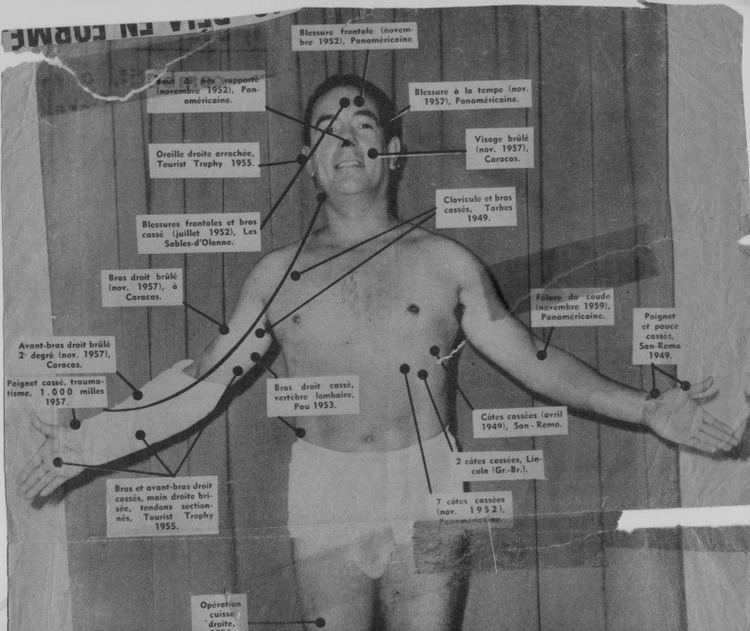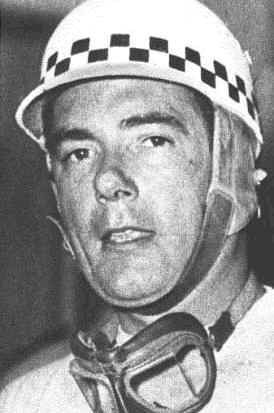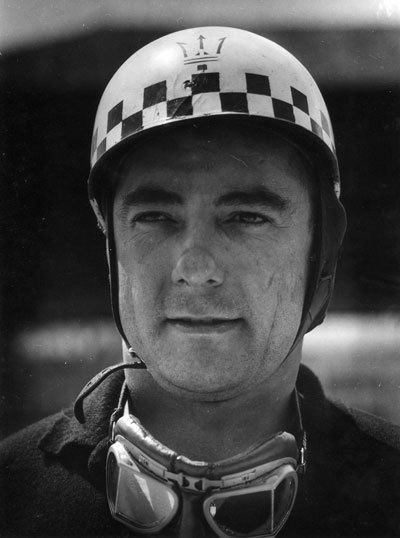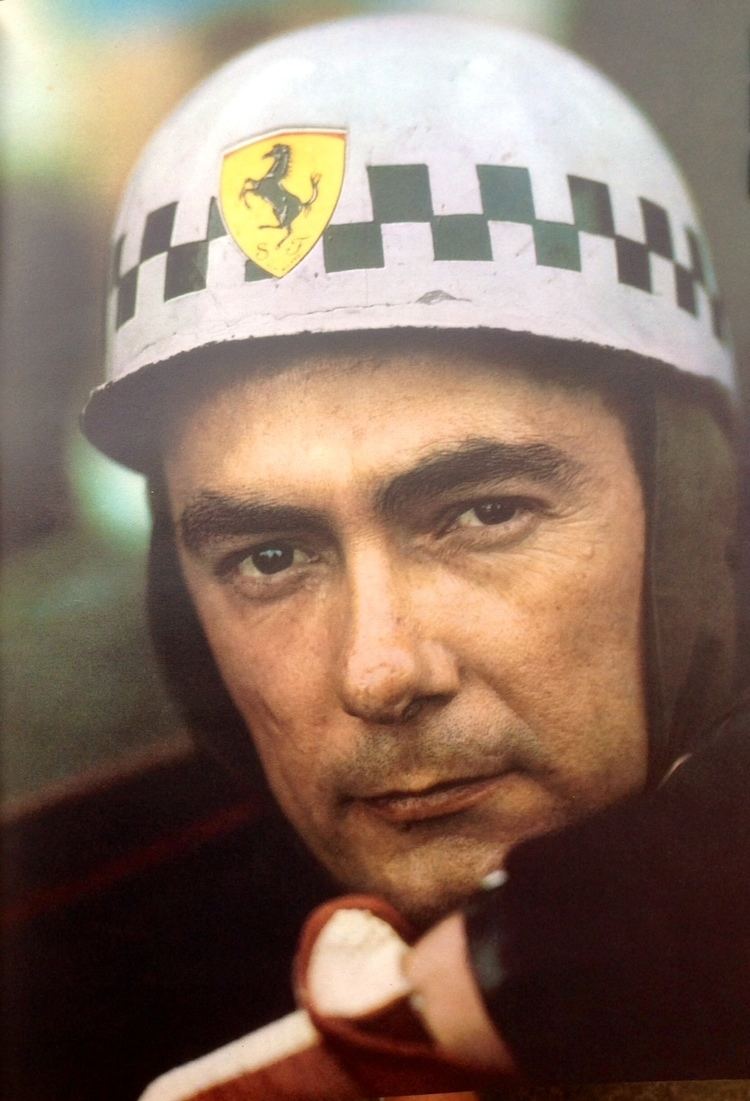Nationality French Wins 0 Active years 1952 – 1959 Name Jean Behra | Entries 53 (52 starts) Championships 0 | |
 | ||
Died August 1, 1959, Berlin, Germany Similar People Peter Collins, Lance Macklin, Dan Gurney, Toni Ulmen, George Abecassis | ||
Jean Behra Horrific Fatal Crash 1959 German Grand Prix at Avus
Jean Marie Behra (born in Nice, France, 16 February 1921 – died in Berlin, Germany, 1 August 1959) was a Formula One driver who raced for the Gordini, Maserati, BRM, Ferrari and Porsche teams.
Contents
- Jean Behra Horrific Fatal Crash 1959 German Grand Prix at Avus
- Accidente de jean behra avi
- Appearance and personality
- Career synopsis
- Gordini
- Maserati
- Porsche
- Final season and death
- Mourning
- Complete Formula One World Championship results
- Non Championship Formula One results
- References

Accidente de jean behra avi
Appearance and personality

Behra was small in stature, stocky, and weighed 178 pounds. Behra had big shoulders and was scarred from 12 crashes. In 1955 he had an ear torn off from a collision. He sometimes drove magnificently and at others he drove with a lack of enthusiasm.
Career synopsis

He raced motorcycles for Moto Guzzi prior to changing to sports cars and Grand Prix racing. Behra began driving cars competitively in 1952. Joakim Bonnier claimed that he learned the majority of his racing skill from Behra. Although he never achieved victory in a World Championship Formula One race, he managed an unquenchable thirst for motorsport, being considered a formidable competitor to the day he died. He hit the headlines when he won the non-title 1952 Reims Grand Prix. Between then and 1959 he scored many victories, but none in Formula One championship races.
Gordini

Behra was in a Gordini in the Panamericana road race in the Mexican state of Oaxaca in November 1952. He won the first stage of the five-day race from Mexico's southern border to the United States border at Ciudad Juárez near El Paso. He started 19th and finished with a time of 3 hours, 41 minutes, and 44 seconds. On the second day of competition Behra crashed his car on a curve approximately fifty miles from Puebla. In April 1954 Behra passed the leader in the last ten minutes on his way to victory in the Grand Prix of Pau, France. He finished 200 yards (180 m) ahead of Maurice Trintignant after having to make many pit stops due to mechanical trouble. Behra drove a six-cylinder Gordini.
Maserati
Behra finished first at the Grand Prix de Pau for a second consecutive year, this time at the wheel of a Maserati. Alberto Ascari led until the 19th lap but dropped back after brake failure. A crowd of 50,000 watched as only eleven of sixteen starters finished the race. Behra and Luigi Musso were teammates in the 1,008 kilometer super-Cortemaggiori Grand Prix at Monza, Italy. The two Italians shared a 3,000 cubic centimeter Maserati that won and established course and lap records for 6.3 kilometer track.
Behra had surgery on his leg in June 1956, forcing him to miss a 1,000 kilometer Monza Grand Prix. He earned the pole position for a Grand Prix at Rouen, France in July 1956. His Maserati was clocked at an average speed of nearly 155.46 kilometers per hour. Behra drove a Maserati to capture the Grand Prix of Rome, a 2,000 cubic centimeters sports car event, in October 1956. His winning distance was 166.030 kilometers. He covered one lap in 2 minutes, 16.9 seconds, to average 174.003 kilometers an hour. This established a record for the Castelfusano track.
In April 1957 Behra turned in the quickest time for the Pau Grand Prix. He circuited the 2.77 meter course in 1 minute 35.7 seconds, which was a half second slower than his lap record time. The race covered a distance of 304.6 kilometers or about 190 miles (310 km). Behra won the race which was run through the streets of Pau, with an average speed of 62.7 mph (100.9 km/h). Behra was injured while testing a car for the Mille Miglia in May 1957. He recovered and entered a Maserati in the 24 hours of Le Mans on 22 June. Behra was triumphant in a Maserati at Kristianstad, Sweden in August 1957. He drove in a Swedish 6-hour Grand Prix at the Rabelov, 6,537 meter, asphalt track. He followed this with a win in the Grand Prix of Modena, Italy in September.
Porsche
Behra drove a Porsche to victory in the 6th Rouen Grand Prix. He bested the British drivers, Graham Hill and Alan Stacey. Behra took 4th place at Oporto in the 1958 Portuguese Grand Prix, driving for British Racing MotorsBRM. He drove a Porsche to achieve first place in the Grand Prix of Berlin, Germany held in September. He navigated the twenty circuits of the 5.19-mile (8.35 km) track with a time of 128.2 mph (206.3 km/h). in 48 minutes, 14.8 seconds. Altogether he scored wins in 8 straight European races in 1958. In each sports car event he piloted a Porsche Spyder. In Formula One he drove exclusively for BRM that year. Behra finished 4th at Riverside International Raceway in a small Porsche RSK, in October 1958. He made a quick exit and took an airplane to Europe, where he left for the Grand Prix of Morocco at Casablanca. He was in such a hurry that he left Riverside, California in an ambulance to make his flight.
Final season and death
In 1959 he moved to Ferrari where he partnered with Tony Brooks. Behra won a 200-mile (320 km) international race of Formula One cars at Aintree, in April 1959. He averaged 88.7 miles per hour in an event in which Brooks took second place, 10 seconds behind. When he retired in the French Grand Prix at Reims-Gueux after a piston failure, Behra was involved in a strong discussion in a restaurant in which he punched team manager Romolo Tavoni and another patron, and was instantly dismissed from the team.
Less than a month later he crashed his Porsche RSK in rainy weather in the sports car race that preceded the German Grand Prix at AVUS, in Berlin, Germany. He was thrown from his car and fatally injured when he hit a flagpole, causing a skull fracture.
The sports car race featured entries of small, under 1,500 c.c. engine capacity. After three laps Behra was third behind Wolfgang von Trips and Bonnier, who eventually finished one and two. The AVUS was unique among race tracks. It used a strip of the Autobahn 2.5 miles (4.0 km) in length. The north and south bound lanes were fifty feet apart. At one end was a hairpin turn which drivers negotiated at around 30 mph (48 km/h). At the other end was a 30-foot (9.1 m) high, steeply banked loop. Behra lost control in the pouring rain, while going 110 mph (180 km/h). The Porsche began to fishtail with the tail of the car going higher and higher up the slick, steep bank. Then the Porsche spun and went over the top of the banking, with its nose pointing toward the sky. It landed heavily on its side on top of the banking. It remained there wrecked, while the race continued on underneath. Behra was thrown out and for a fleeting moment he could be seen against the background of the sky, with his arms outstretched as though attempting to fly. He impacted one of eight flagpoles arranged at the summit of the embankment which bore the flags of the competing nations. The flagpole toppled over when Behra collided with it, about halfway to its top.
Behra came down into trees and rolled almost into a street where drivers and cars often waited in a paddock to practice. A doctor arrived from a Red Cross ambulance close by. He examined Behra briefly and shook his head. A hospital bulletin stated that Behra broke most of his ribs in addition to the skull fracture which killed him. Currently AVUS is a vital part of the German public highway system as Autobahn A 115.
Mourning
Behra was buried in Nice, France six days after the crash in which he died on 1 August. In between there were three funeral services. 3,000 mourners in Nice lined the streets from wall to wall. The first funeral service was in Berlin, followed by another in Paris.
Behra left a nineteen-year-old son, Jean Paul. Behra's demise left only Maurice Trintignant among living French drivers of fame. Trintignant comforted Behra's family and called on the young men of France to defend the colours of their country in international motor racing. Conspicuously absent among those present in the racing community was Enzo Ferrari. He dropped Behra as a factory driver ten days before his death and sent no remembrance to the funeral masses.
Complete Formula One World Championship results
(key) (Race in italics indicates fastest lap (shared))
* Indicates shared drive with Harry Schell† Indicates shared drive with Cesare Perdisa‡ Indicates shared drive with Roberto MieresNon-Championship Formula One results
(key)
* Indicates shared drive with André Simon† Indicates shared drive with Jacques Pollet